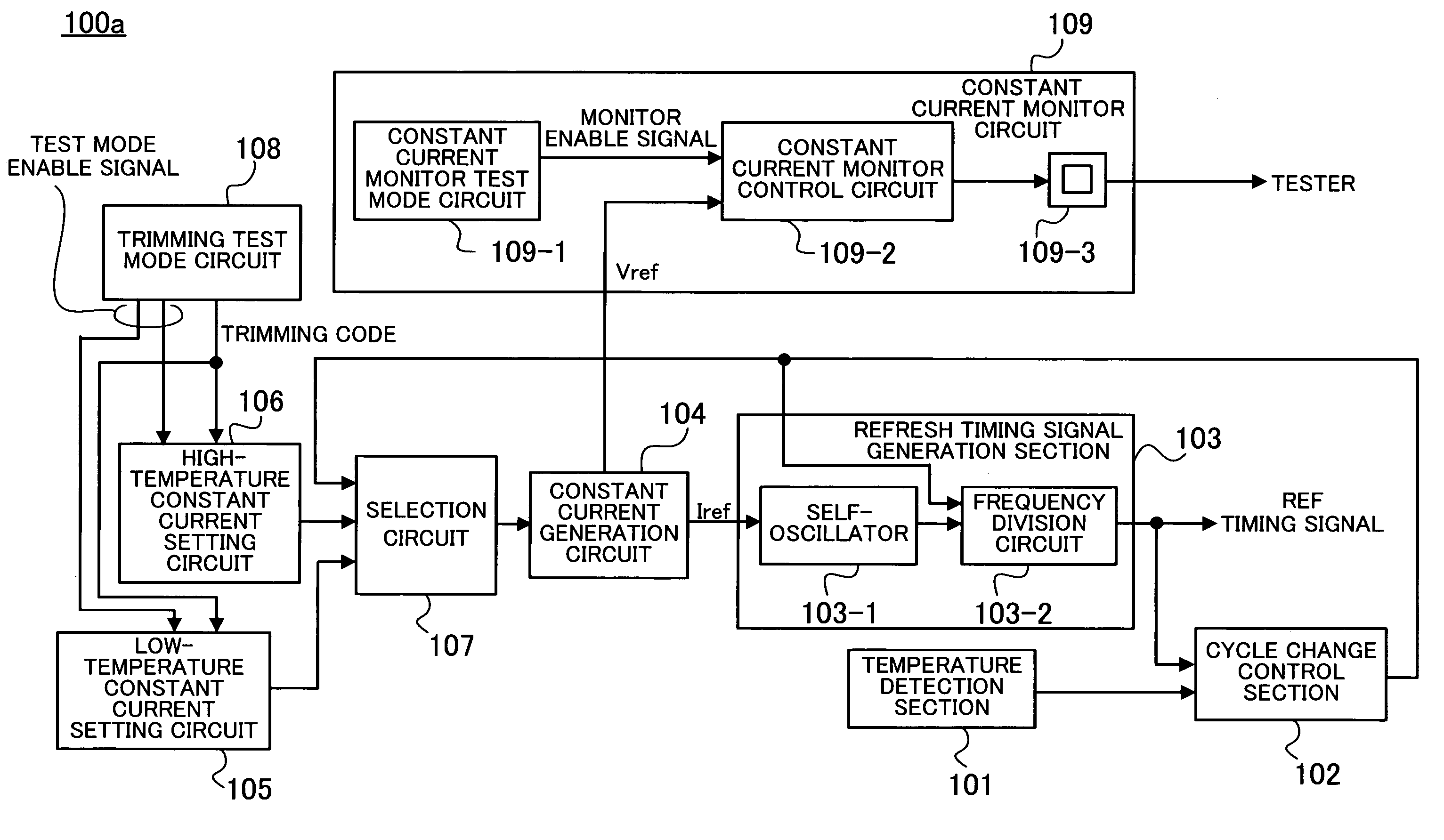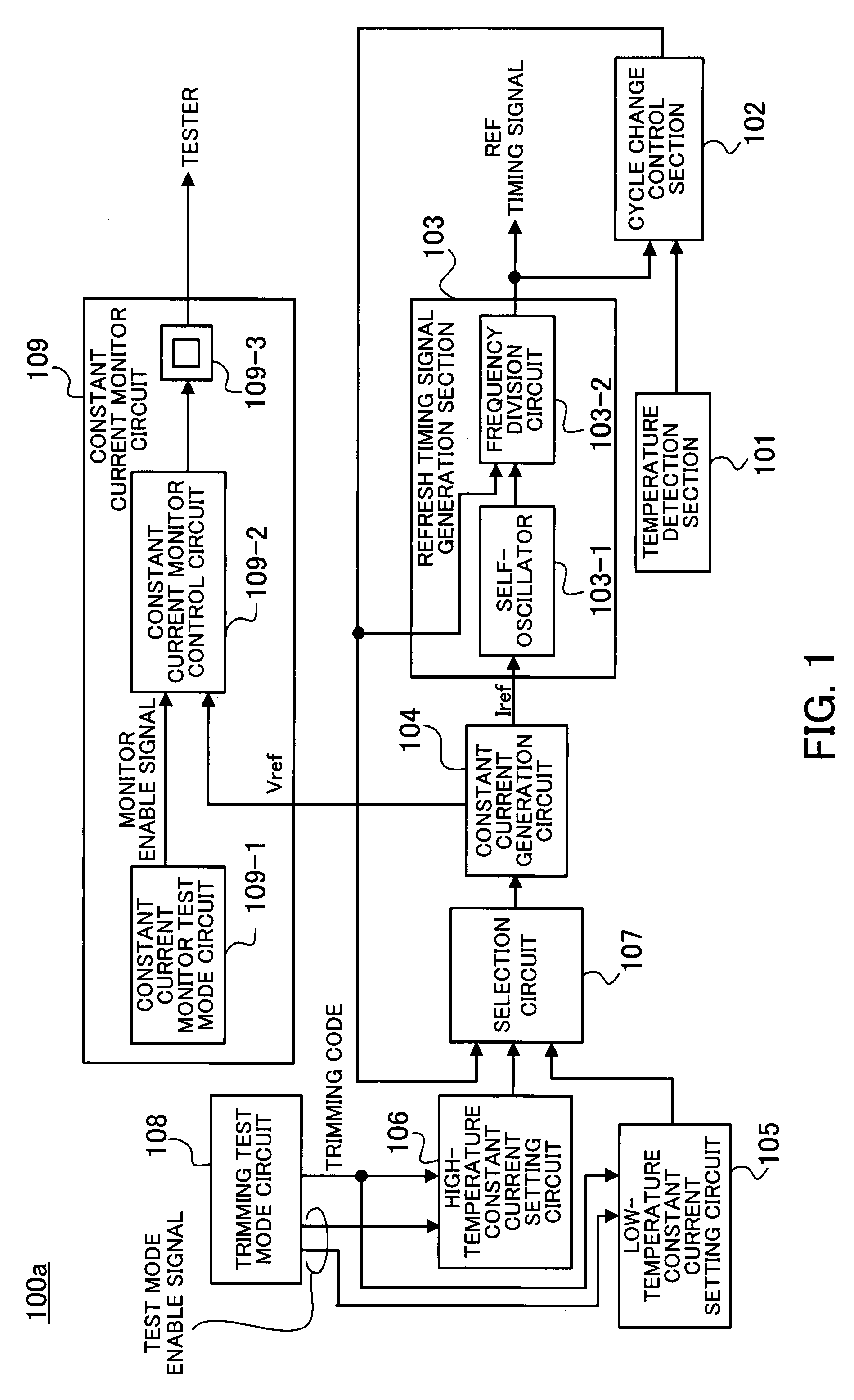Semiconductor memory and refresh cycle control method
a technology of memory and memory cells, applied in the direction of information storage, static storage, digital storage, etc., can solve the problems of data loss, short refresh cycle, etc., and achieve the effect of reducing standby curren
- Summary
- Abstract
- Description
- Claims
- Application Information
AI Technical Summary
Benefits of technology
Problems solved by technology
Method used
Image
Examples
first embodiment
[0037]FIG. 1 shows the structure of a semiconductor memory according to the present invention.
[0038]A semiconductor memory 100a according to a first embodiment of the present invention comprises a temperature detection section 101 for detecting temperature, a cycle change control section 102, a refresh timing signal generation section 103, a constant current generation circuit 104, a low-temperature constant current setting circuit 105, a high-temperature constant current setting circuit 106, a selection circuit 107, a trimming test mode circuit 108, and a constant current monitor circuit 109.
[0039]The temperature detection section 101 detects the temperature of the semiconductor memory 100a.
[0040]When temperature detected by the temperature detection section 101 reaches a cycle change temperature (60° C., for example), the cycle change control section 102 sends a cycle change signal for changing a refresh cycle.
[0041]The refresh timing signal generation section 103 includes a self-...
second embodiment
[0077]A semiconductor memory according to the present invention will now be described.
[0078]FIG. 6 shows the structure of a semiconductor memory according to a second embodiment of the present invention.
[0079]Components of a semiconductor memory according to a second embodiment of the present invention that are the same as those of the semiconductor memory 100a according to the first embodiment of the present invention are marked with the same symbols and descriptions of them will be omitted.
[0080]A semiconductor memory 100b according to a second embodiment of the present invention differs from the semiconductor memory 100a according to the first embodiment of the present invention in that it includes a temperature dependence information storage section 130 for storing information indicative of the dependence of current Iref on temperature measured at test time. In addition, a selection circuit 107a included in the semiconductor memory 100b differs partly from the selection circuit ...
third embodiment
[0084]A semiconductor memory according to the present invention will now be described.
[0085]FIG. 7 shows the structure of a semiconductor memory according to a third embodiment of the present invention.
[0086]Components of a semiconductor memory according to a third embodiment of the present invention that are the same as those of the semiconductor memories 100a and 100b according to the first embodiment and the second embodiment, respectively, of the present invention are marked with the same symbols and descriptions of them will be omitted.
[0087]As with the semiconductor memory 100b according to the second embodiment of the present invention, a semiconductor memory 100c according to a third embodiment of the present invention includes a temperature dependence information storage section 130 for storing the dependence of current Iref on temperature. Unlike the semiconductor memory 100b according to the second embodiment of the present invention, however, the semiconductor memory 100...
PUM
 Login to View More
Login to View More Abstract
Description
Claims
Application Information
 Login to View More
Login to View More - R&D
- Intellectual Property
- Life Sciences
- Materials
- Tech Scout
- Unparalleled Data Quality
- Higher Quality Content
- 60% Fewer Hallucinations
Browse by: Latest US Patents, China's latest patents, Technical Efficacy Thesaurus, Application Domain, Technology Topic, Popular Technical Reports.
© 2025 PatSnap. All rights reserved.Legal|Privacy policy|Modern Slavery Act Transparency Statement|Sitemap|About US| Contact US: help@patsnap.com



